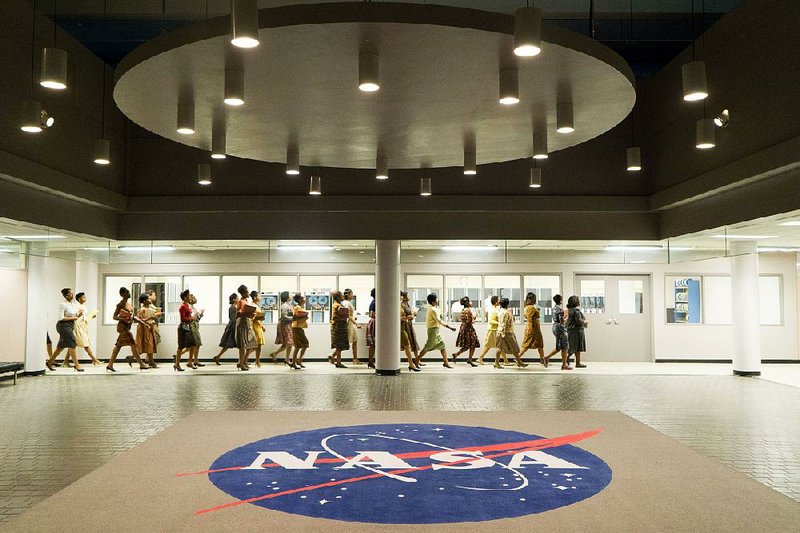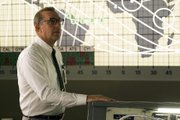A nice enough message movie with a trio of fine performances at its core, Hidden Figures is nevertheless overly safe and inappropriately comforting, fitting squarely in the well-established minorities-overcoming-adversity-with-dignity genre. It's a good family film in the sense that it probably won't upset anyone, but it's hard to escape the suspicion the real people on whose stories it is based deserve a more nuanced treatment, one that's less slavishly devoted to the conventional notions of America's Cold War and civil rights mythologies.
Hidden Figures is exactly what you'd expect it to be; predictably handsomely mounted and a little too Disney bright, blandly directed with a happy ending that feels overreaching and inevitable. It follows the same mildly revisionist pattern of a lot of pop culture stories in that it revisits what we assume is a well-known story only to point out some unsung heroes. In The Imitation Game, we were instructed that a gay man probably saved thousands of lives by shortening World War II. In Hidden Figures -- the blatancy of the multilayer title is itself a minor problem (it also refers to the deep math that made the space race possible) -- we learn how black female mathematicians (called "computers") helped put a man on the moon.
Hidden Figures
83 Cast: Taraji P. Henson, Octavia Spencer, Janelle Monae, Kevin Costner, Kirsten Dunst, Jim Parsons, Mahershala Ali, Aldis Hodge, Glen Powell, Kimberly Quinn, Olek Krupa
Director: Theodore Melfi
Rating: PG, for thematic elements and some language
Running time: 2 hours, 7 minutes
This is a story worth telling, though we might wish it'd been told in a more serious and less breathless manner. Instead writer-director Theodore Melfi (who made the excellent St. Vincent a couple of years ago) elects to crank up the contrast and overstate the obvious. It's not enough that the story is set in Virginia in 1961; our three heroines -- played by Taraji P. Henson, Octavia Spencer and Janelle Monae -- have to explain their trepidation when a white cop rolls up on the disabled Impala that is carrying them to their commute.
And sure enough, the cop's a caricatured racist, albeit one who knows his patriotic duty when confronted with the ladies' NASA credentials. (While it's important to keep black folks in their place, it's more important to beat the Ruskies into space!) Soon he's giving them a lights-and-siren escort to NASA's Langley campus, where they do their important pencil work in a segregated hangar away from the glory that accrues to their white male colleagues -- the strapping astronauts, steely mission control desk jockeys and socially awkward but brilliant engineers familiar from Apollo 13, The Right Stuff and similar histories.
But scientists as a rule have no time for cultural conventions based on concepts as silly as race, so when Katherine G. Johnson (Henson) displays some genius-level computational skills, gruff but lovable Space Task Group Leader Al Harrison (Kevin Costner) brings her onto his elite team to plot the launch of an astronaut into orbit. Harrison doesn't care if you're black or white or green so long as you're of use, and he won't tolerate bigotry among members of his team.
Johnson is a real person. She's still alive at 98, and she has been honored with a Presidential Medal of Freedom. There's a building named for her at Langley. Henson plays her as a quiet but fiercely insistent woman whose formidable intellect mandates her place at the table. To have excluded her would have been a dereliction of duty -- it might have put lives at risk. Serious people don't indulge superstitions.
Likewise, Dorothy Vaughan (Spencer) and Mary Jackson (Monae) were real people who distinguished themselves as members of the program while suffering ugly yet routine indignities due to the embedded racism and sexism of the time and institution. But the movie doesn't allow these characters much time, and their characters seem to exist mainly to interact with Johnson (admittedly the best part of the movie is the chemistry among these three actors). Far too much of the film is given over to repetitive moments when these ladies demonstrate how they've (once again) been underestimated.
And it's disconcerting how often the film seems to default to a patronizing do-gooder view of racism as a symptom of moral failure rather than an insidious and inherent feature of society. In the world of Hidden Figures, racists are stupid and smug and/or mean and easy to spot. They're discrete actors -- bad people -- who can be won over by the third act. No one watching this movie is likely to identify with any of them. (For Hidden Figures is not the sort of movie mean and ugly people go to see.)
Contrast this to Jeff Nichols' Loving, where racists could afford to speak softly, knowing they had the authority of the state (or the Bible) backing them up.
But let's understand that it's only a movie, and that Melfi's breezy approach doesn't invite much reflection. At the end we get to cheer, and a year after #oscarssowhite it feels good to know that the talents of Henson, Spencer and Monae have been showcased in a major motion picture with a respectable budget and award aspirations.
Let's all give ourselves (another) round of applause.
MovieStyle on 01/06/2017



